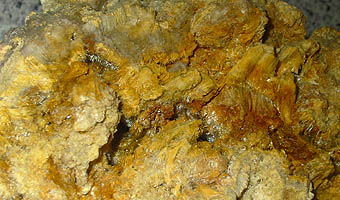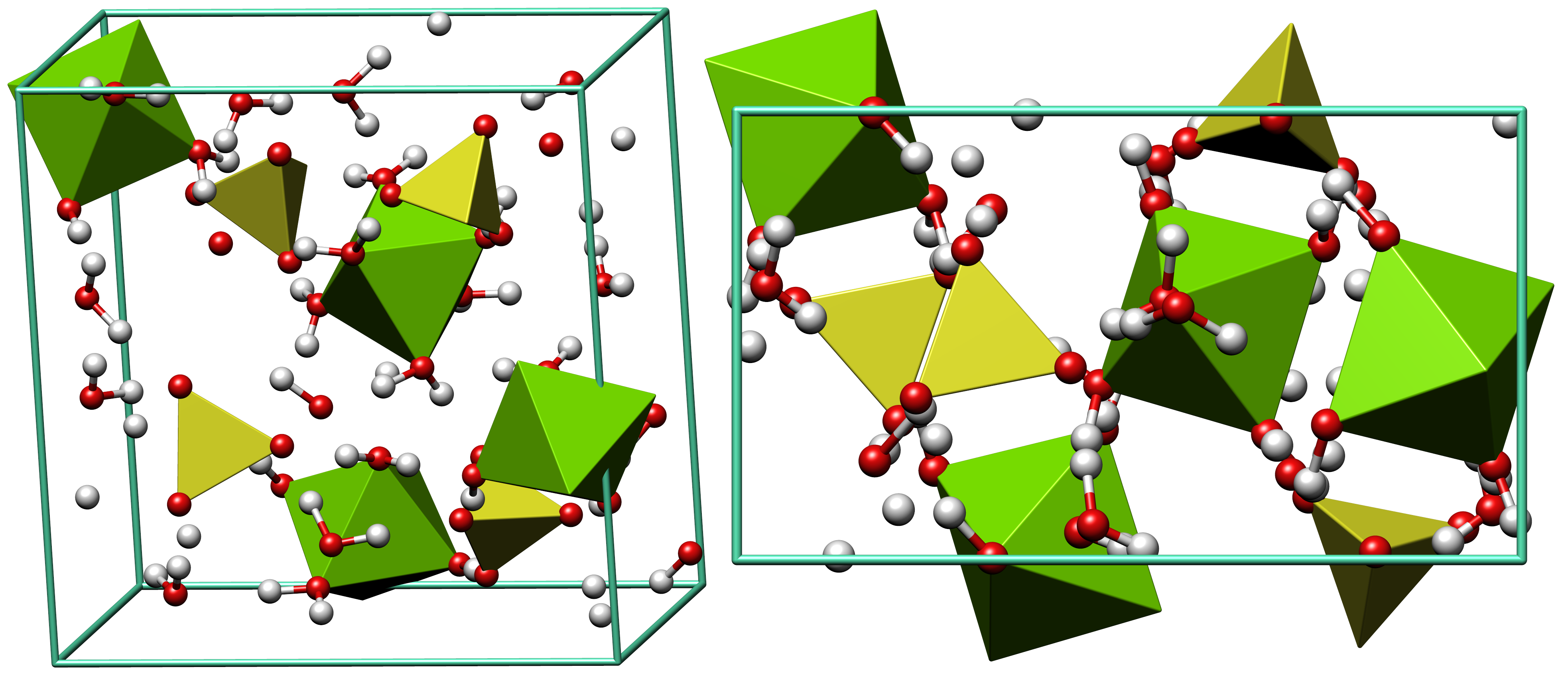|
Sulfate Minerals
The sulfate minerals are a class of minerals that include the sulfate ion () within their structure. The sulfate minerals occur commonly in primary evaporite depositional environments, as gangue minerals in hydrothermal veins and as secondary minerals in the oxidizing zone of sulfide mineral deposits. The chromate and manganate minerals have a similar structure and are often included with the sulfates in mineral classification systems.Klein, Cornelis and Cornelius S. Hurlbut, 1985, ''Manual of Mineralogy,'' 20th ed., John Wiley and Sons, New York, pp. 347–354 . Sulfate minerals include: *Anhydrous sulfates ** Barite BaSO4 ** Celestite SrSO4 ** Anglesite PbSO4 ** Anhydrite CaSO4 ** Hanksite Na22K(SO4)9(CO3)2Cl *Hydroxide and hydrous sulfates ** Gypsum CaSO4·2H2O **Chalcanthite CuSO4·5H2O ** Kieserite MgSO4·H2O ** Starkeyite MgSO4·4H2O ** Hexahydrite MgSO4·6H2O ** Epsomite MgSO4·7H2O ** Meridianiite MgSO4·11H2O **Melanterite FeSO4·7H2O ** Antlerite Cu3SO4(OH)4 ** ... [...More Info...] [...Related Items...] OR: [Wikipedia] [Google] [Baidu] |
Mineral
In geology and mineralogy, a mineral or mineral species is, broadly speaking, a solid substance with a fairly well-defined chemical composition and a specific crystal structure that occurs naturally in pure form.John P. Rafferty, ed. (2011): Minerals'; p. 1. In the series ''Geology: Landforms, Minerals, and Rocks''. Rosen Publishing Group. The Geology, geological definition of mineral normally excludes compounds that occur only in living organisms. However, some minerals are often biogenic (such as calcite) or organic compounds in the sense of chemistry (such as mellite). Moreover, living organisms often synthesize inorganic minerals (such as hydroxylapatite) that also occur in rocks. The concept of mineral is distinct from rock (geology), rock, which is any bulk solid geologic material that is relatively homogeneous at a large enough scale. A rock may consist of one type of mineral or may be an aggregate (geology), aggregate of two or more different types of minerals, spaci ... [...More Info...] [...Related Items...] OR: [Wikipedia] [Google] [Baidu] |
Gypsum
Gypsum is a soft sulfate mineral composed of calcium sulfate Hydrate, dihydrate, with the chemical formula . It is widely mined and is used as a fertilizer and as the main constituent in many forms of plaster, drywall and blackboard or sidewalk chalk. Gypsum also Crystallization, crystallizes as translucent crystals of selenite (mineral), selenite. It forms as an evaporite mineral and as a Mineral hydration, hydration product of anhydrite. The Mohs scale of mineral hardness defines gypsum as hardness value 2 based on Scratch hardness, scratch hardness comparison. Fine-grained white or lightly tinted forms of gypsum known as alabaster have been used for sculpture by many cultures including Ancient Egypt, Mesopotamia, Ancient Rome, the Byzantine Empire, and the Nottingham alabasters of Medieval England. Etymology and history The word ''wikt:gypsum, gypsum'' is derived from the Greek language, Greek word (), "plaster". Because the quarry, quarries of the Montmartre district of P ... [...More Info...] [...Related Items...] OR: [Wikipedia] [Google] [Baidu] |
Strunz Classification
Strunz can refer to: * Claudio Strunz (born 1966), Argentine drummer * Claus Strunz (born 1966), German journalist * Thomas Strunz, (born 1968), German soccer player * Strunz classification in mineralogy * Strunz & Farah, a band {{Disambig, surname ... [...More Info...] [...Related Items...] OR: [Wikipedia] [Google] [Baidu] |
International Mineralogical Association
Founded in 1958, the International Mineralogical Association (IMA) is an international group of 40 national societies. The goal is to promote the science of mineralogy and to standardize the nomenclature of the 5000 plus known mineral species. The IMA is affiliated with the International Union of Geological Sciences (IUGS). The Association supports the activities of Commissions and Working Groups involved on certain aspects of mineralogical practice and facilitates interactions among mineralogists by sponsoring and organising meetings. In particular, the IMA holds its general meeting every four years. The last meeting was scheduled in 2022 in Lyon, France. Presidents The presidents of the IMA have been: * since 2024: Eiji Ohtani ** Tohoku University * 2022–2024: Hans-Peter Schertl ** Bochum University * 2020–2022: Anhuai Lu ** Peking University *2018–2020: Patrick Cordier ** Université de Lille *2016–2018: Peter C. Burns ** University of Notre Dame *2014–2016 ... [...More Info...] [...Related Items...] OR: [Wikipedia] [Google] [Baidu] |
Jarosite
Jarosite is a basic hydrous sulfate of potassium and ferric iron (Fe-III) with a chemical formula of KFe3(SO4)2(OH)6. This sulfate mineral is formed in ore deposits by the oxidation of iron sulfides. Jarosite is often produced as a byproduct during the purification and refining of zinc and is also commonly associated with acid mine drainage and acid sulfate soil environments. Physical properties Jarosite has a trigonal crystal structure and is brittle, with basal cleavage, a hardness of 2.5–3.5, and a specific gravity of 3.15–3.26. It is translucent to opaque with a vitreous to dull luster, and is colored dark yellow to yellowish-brown. It can sometimes be confused with limonite or goethite with which it commonly occurs in the gossan (oxidized cap over an ore body). Jarosite is an iron analogue of the potassium aluminium sulfate, alunite. Solid solution series The alunite supergroup includes the alunite, jarosite, beudantite, crandallite and florencite subgroups. Th ... [...More Info...] [...Related Items...] OR: [Wikipedia] [Google] [Baidu] |
Alunite
Alunite is a hydroxylated aluminium potassium sulfate mineral, formula potassium, Kaluminium, Al3(sulfur, Soxygen, O4)2(Ohydrogen, H)6. It was first observed in the 15th century at Tolfa, near Rome, where it was mined for the manufacture of alum. First called ''aluminilite'' by Jean-Claude Delamétherie, J.C. Delamétherie in 1797, this name was contracted by François Sulpice Beudant, François Beudant three decades later to alunite. Alunite crystals morphologically are rhombohedron, rhombohedra with interfacial angles of 90° 50', causing them to resemble cubes. Crystal symmetry is trigonal. Minute glistening crystals have also been found loose in cavities in altered rhyolite. Alunite varies in color from white to yellow gray. The hardness on the Mohs scale is 4 and the specific gravity is between 2.6 and 2.8. It is insoluble in water or weak acids, but soluble in sulfuric acid. Sodium can substitute for potassium in the mineral, and when the sodium content is high, is call ... [...More Info...] [...Related Items...] OR: [Wikipedia] [Google] [Baidu] |
Brochantite
Brochantite is a sulfate mineral, one of a number of cupric sulfates. Its chemical formula is Cu4SO4(OH)6. Formed in arid climates or in rapidly oxidizing copper sulfide deposits, it was named by Armand Lévy (mineralogist), Armand Lévy for his fellow France, Frenchman, geologist and mineralogist André-Jean-François-Marie Brochant de Villiers, A. J. M. Brochant de Villiers. Crystals of brochantite can range from emerald green to black-green to blue-green, and can be acicular or prismatic. Brochantite is often associated with minerals such as malachite, azurite, and chrysocolla, and may form pseudomorphs with these minerals. The mineral is found in a number of locations around the world, notably the southwestern United States (especially Arizona), Serifos in Greece and Chile. Brochantite is a common corrosion product on bronze sculptures located in urban areas, where atmospheric sulfur dioxide (a common pollutant) is present. Brochantite forms mainly in exposed areas where wea ... [...More Info...] [...Related Items...] OR: [Wikipedia] [Google] [Baidu] |
Antlerite
Antlerite is a greenish hydrous copper sulfate mineral, with the formula Cu3(SO4)(OH)4. It occurs in tabular, Acicular (crystal habit), acicular, or fibrous crystals with a vitreous lustre, vitreous luster. Originally believed to be a rare mineral, antlerite was found to be the primary ore of the Gossan, oxidised zones in several copper extraction, copper mines across the world, including the Chuquicamata mine in Chile, and the Antler mine in Arizona, United States of America, US from which it takes its name. It is chemically and optically similar in many respects to other copper minerals such as malachite and brochantite, though it can be distinguished from the former by a lack of effervescence in hydrochloric acid. Antlerite is a common corrosion product on bronze sculptures located in urban areas, where atmospheric sulfur dioxide (a common pollutant) is present. Antlerite forms mainly in sheltered areas where weathering is low, which permits accumulation of copper ions and enha ... [...More Info...] [...Related Items...] OR: [Wikipedia] [Google] [Baidu] |
Melanterite
Melanterite is a mineral form of hydrous iron(II) sulfate: FeSO4·7H2O. It is the iron analogue of the copper sulfate chalcanthite. It alters to siderotil by Dehydration, loss of water. It is a secondary sulfate mineral which forms from the oxidation of primary sulfide minerals such as pyrite and marcasite in the near-surface environment. It often occurs as a ''post mine'' encrustation on old underground mine surfaces. It also occurs in coal and lignite seams exposed to humid air and as a rare Volcanic sublimate, sublimate phase around volcanic fumaroles. Associated minerals include pisanite, chalcanthite, epsomite, pickeringite, halotrichite and other sulfate minerals. It was first described in 1850. Gallery File:Melanterite crystal structure.png, Crystal structure of melanterite File:Cuprian Melanterite - Parys Mountain Mines, Amlwch, Isle of Anglesey, Wales, UK.jpg, Cuprian melanterite References Sulfate minerals Iron(II) minerals Monoclinic minerals Minerals in spa ... [...More Info...] [...Related Items...] OR: [Wikipedia] [Google] [Baidu] |
Meridianiite
Meridianiite is the mineral consisting of magnesium sulfate undecahydrate, . It is colorless transparent crystalline salt that precipitates from solutions saturated in Mg2+ and SO42− ions at temperatures less than 2 °C. The synthetic compound was formerly known as Fritzsche's salt. Meridianiite is a naturally occurring mineral species found on Earth in a variety of environments including sea ice, crusts and efflorescences in coal/metal mines, cave systems, oxidized zones of sulfide deposits, salt lakes/playas and Antarctic ice-cores. It is commonly associated with other evaporite minerals such as epsomite, mirabilite, halides, and other sodium-magnesium-sulfates. There is some evidence that it was once present on the surface of Mars, and may occur in several bodies of the Solar System. As of 2012, it was the only undecahydrate sulfate known. Properties Meridianiite belongs to the triclinic crystal system, having cell parameters a = 6.7459 Å, b = 6.8173 Å, c = ... [...More Info...] [...Related Items...] OR: [Wikipedia] [Google] [Baidu] |
Epsomite
Epsomite, Epsom salt, or magnesium sulfate heptahydrate, is a hydrous magnesium sulfate mineral with formula . Physical properties Epsomite crystallizes in the orthorhombic system. The normal form is as massive encrustations, while acicular or fibrous crystals are rarely found. It is colorless to white with tints of yellow, green and pink. It is a soft mineral with variable Mohs hardness around 2.0~2.5, and it has a low specific gravity It is readily soluble in water, and absorbs water from the air. It converts to hexahydrate with the loss of one water molecule and a switch to monoclinic structure. The epsomite group includes solid solution series with morenosite (·) and goslarite (·). Etymology It was first systematically described in 1806 for an occurrence near Epsom, Surrey, England, after which it was named. It has been also referred to as "cave cotton" when in its fibrous form. Occurrence Epsomite forms as encrustations or efflorescences on limestone caver ... [...More Info...] [...Related Items...] OR: [Wikipedia] [Google] [Baidu] |
Hexahydrite
Magnesium sulfate or magnesium sulphate is a chemical compound, a salt with the formula , consisting of magnesium cations (20.19% by mass) and sulfate anions . It is a white crystalline solid, soluble in water but not in ethanol. Magnesium sulfate is usually encountered in the form of a hydrate , for various values of ''n'' between 1 and 11. The most common is the heptahydrate , known as Epsom salt, which is a household chemical with many traditional uses, including bath salts. The main use of magnesium sulfate is in agriculture, to correct soils deficient in magnesium (an essential plant nutrient because of the role of magnesium in chlorophyll and photosynthesis). The monohydrate is favored for this use; by the mid 1970s, its production was 2.3 million tons per year. The anhydrous form and several hydrates occur in nature as minerals, and the salt is a significant component of the water from some springs. Hydrates Magnesium sulfate can crystallize as several hydrates, i ... [...More Info...] [...Related Items...] OR: [Wikipedia] [Google] [Baidu] |





